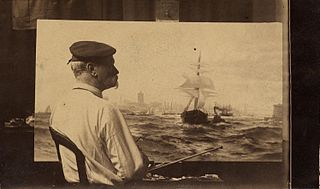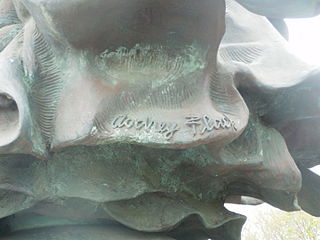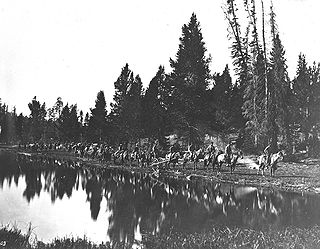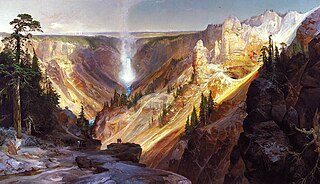
The Grand Canyon of the Yellowstone is an oil on canvas painting by English American artist Thomas Moran, created in 1893-1901. It is held at the Smithsonian American Art Museum, in Washington, D.C.

The Grand Canyon of the Yellowstone is an oil on canvas painting by English American artist Thomas Moran, created in 1893-1901. It is held at the Smithsonian American Art Museum, in Washington, D.C.
Moran was part of a geological survey expedition to Yellowstone, in 1871, which, followed by other visits to the American West in the next years, had a lasting effect on him, and inspired him to create several idealized depictions of that part of the country. Moran did a first painting named The Grand Canyon of the Yellowstone in 1872. He spent several days sketching the scene and he moved around getting different vantage points of the Grand Canyon. [1] [2] The expedition had a fundamental effect in the decision to create the Yellowstone National Park, taken by the U.S. Congress, in 1872. [3]
The current painting is from a later time, and he worked in it from 1893 to 1901. It is majestic in its depiction of the Grand Canyon of Yellowstone, in particular of the Yellowstone River, descending from a waterfall to the canyon, and the desolated and mountainous landscape, punctuated with some trees. [4]
According to Audrey Reinhardt, the painting "is impressive not only in terms of its masterful execution and sheer size—14 feet by 8 feet—but in terms of how it codified images of the United States’ natural wonders of the West in the minds of Americans." [3]

John Wesley Powell was an American geologist, U.S. Army soldier, explorer of the American West, professor at Illinois Wesleyan University, and director of major scientific and cultural institutions. He is famous for his 1869 geographic expedition, a three-month river trip down the Green and Colorado rivers, including the first official U.S. government-sponsored passage through the Grand Canyon.

Thomas Moran was an American painter and printmaker of the Hudson River School in New York whose work often featured the Rocky Mountains. Moran and his family, wife Mary Nimmo Moran and daughter Ruth took residence in New York where he obtained work as an artist. He was a younger brother of the noted marine artist Edward Moran, with whom he shared a studio. A talented illustrator and exquisite colorist, Thomas Moran was hired as an illustrator at Scribner's Monthly. During the late 1860s, he was appointed the chief illustrator for the magazine, a position that helped him launch his career as one of the premier painters of the American landscape, in particular, the American West.

The Grand Canyon of the Yellowstone is the first large canyon on the Yellowstone River downstream from Yellowstone Falls in Yellowstone National Park in Wyoming. The canyon is approximately 24 miles (39 km) long, between 800 and 1,200 ft deep and from 0.25 to 0.75 mi wide.

William Henry Holmes, known as W. H. Holmes, was an American explorer, anthropologist, archaeologist, artist, scientific illustrator, cartographer, mountain climber, geologist and museum curator and director.

Yellowstone Falls consist of two major waterfalls on the Yellowstone River, within Yellowstone National Park, Wyoming, United States. As the Yellowstone river flows north from Yellowstone Lake, it leaves the Hayden Valley and plunges first over Upper Falls of the Yellowstone River and then a quarter mile downstream over Lower Falls of the Yellowstone River, at which point it then enters the Grand Canyon of the Yellowstone, which is up to 1,000 feet deep.

The Amon Carter Museum of American Art (ACMAA) is located in Fort Worth, Texas, in the city's cultural district. The museum's permanent collection features paintings, photography, sculpture, and works on paper by leading artists working in the United States and its North American territories in the nineteenth and twentieth centuries. The greatest concentration of works falls into the period from the 1820s through the 1940s. Photographs, prints, and other works on paper produced up to the present day are also an area of strength in the museum's holdings.

Edward Moran was an English-born American artist of maritime paintings. He is arguably most famous for his series of 13 historical paintings of United States marine history.
Grand Canyon most often refers to:

Audrey Flack is an American artist. Her work pioneered the art genre of photorealism and encompasses painting, printmaking, sculpture, and photography.

Tower Fall is a waterfall on Tower Creek in the northeastern region of Yellowstone National Park, in the U.S. state of Wyoming. Approximately 1,000 yards (910 m) upstream from the creek's confluence with the Yellowstone River, the fall plunges 132 feet (40 m). Its name comes from the rock pinnacles at the top of the fall. Tower Creek and Tower Fall are located approximately three miles south of Roosevelt Junction on the Tower-Canyon road.

The Hayden Geological Survey of 1871 explored the region of northwestern Wyoming that later became Yellowstone National Park in 1872. It was led by geologist Ferdinand Vandeveer Hayden. The 1871 survey was not Hayden's first, but it was the first federally funded geological survey to explore and further document features in the region soon to become Yellowstone National Park, and played a prominent role in convincing the U.S. Congress to pass the legislation creating the park. In 1894, Nathaniel P. Langford, the first park superintendent and a member of the Washburn-Langford-Doane Expedition which explored the park in 1870, wrote this about the Hayden expedition:
We trace the creation of the park from the Folsom-Cook expedition of 1869 to the Washburn expedition of 1870, and thence to the Hayden expedition of 1871, Not to one of these expeditions more than to another do we owe the legislation which set apart this "pleasuring-ground for the benefit and enjoyment of the people"

Mary Nimmo Moran was an American 19th-century landscape printmaker, specializing in etchings. The first woman to prove "marriage and family were not insurmountable to success." She was the first of many landscape artists and in 1880 she was known as a landscape etcher. She completed roughly 70 landscape etchings, which included scenes of England and Scotland, as well as Long Island, New York; New Jersey, Florida, and Pennsylvania. In 1881, she was one of eight Americans and the first female elected as a fellow to London's Royal Society of Painter-Etchers. Mary Nimmo Moran's landscape View of Newark from the Meadows is in the collection of The Newark Museum of Art. She was among the earliest American Artists to explore the medium of etching.

Lucien Whiting Powell (1846–1930) was a renowned landscape painter who gave the village of Airmont, Virginia its name for its scenic westward views. Powell, himself, could be considered a native of Airmont, having been born a few miles southeast, near Upperville, Virginia.

Artist Point is an overlook point on the edge of a cliff on the south rim of the Grand Canyon of the Yellowstone in Yellowstone National Park, Wyoming. The point is located east-northeast of Yellowstone Falls on the Yellowstone River. Artist Point was originally named in 1883 by Frank Jay Haynes who improperly believed that the point was the place at which painter Thomas Moran sketched his 1872 depictions of the falls. Later work determined that the sketches were made from the north rim, but the name Artist Point stuck.

Charles T. Webber was an American painter. Webber created hundreds of paintings during his lifetime, including portraits, landscapes, mythological and historical scenes, as well as genre subjects. He was an active member in Cincinnati’s art scene, founding many artistic groups, and was also a prominent figure in the Underground Railroad. In Cincinnati in particular, Webber was held in high regard due to his artistic achievements.

Richard Norris Brooke was an American painter known especially for his genre scenes depicting African-American subjects. He has been described as "first among several artists who brought a national distinction to the Washington art community, and who were instrumental in making it more professional through the establishment of schools, clubs, and exhibitions."

The Three Tetons is an 1895 oil painting by Thomas Moran. It depicts Grand Teton and the neighbouring peaks of Middle Teton and South Teton, from the Idaho side. The National Park Service describes Moran as, after Albert Bierstadt, the "other 'grand' painter of the Tetons".

Edith Loring Getchell(1855 – 1940) was an American landscape painter and etcher, highly regarded for the "exquisite" tonalism of her etchings, drypoints and watercolors." Working during the "American Etching Revival," a period that lent legitimacy to an art form that had once been scorned as commercial, Getchell made use of the opportunities the vogue for etching gave her, despite a crowded field and the gender discrimination of her era. Considered one of America's leading etchers in her lifetime, Getchell's work is notable for its skill, its aesthetic values and its approach to depicting American landscape.

The Grand Canyon of the Yellowstone is an oil on canvas painting created by English-American artist Thomas Moran in 1872. It is credited with increasing the American public's interest in conservation efforts. The painting is on display in the United States Capitol.

Grand Canyon of the Colorado River is an oil on canvas painting by English–American artist Thomas Moran, created in 1892 and 1908. The painting is held at the Philadelphia Museum of Art.